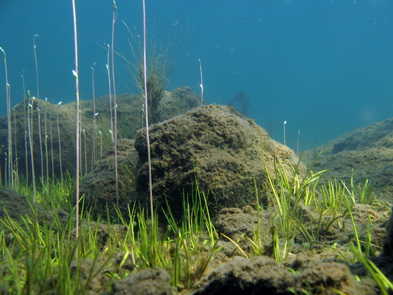Eco-physiology of aquatic rosette plant species
Lobelia dortmanna and Isoetes lacustris growing side-by-side in shallow water in a Norwegian lobelia lake. In many cases, there is a clear zonation of aquatic rosette plant species - especially in deeper lakes. Here, Littorella uniflora (shoreweed) grow in the interface between land and water with individual of Isoetes echinospora here and there. Then, there is a wide zone primarily dominated by Lobelia dortmanna before the last zone of Isoetes lacutris appear in deeper waters.
It is not known why the aquatic rosette species only appear in carbonate-poor lakes although it is assumed that pondweeds and other aquatic plants that are able to utilize bicarbonate as pool of inorganic carbon out-compete the tiny plants in waters with higher alkalinity (bicarbonate and carbonate).
The project will be co-supervised with Lars Båstrup-Spohr.
Isoetids is a group of aquatic rosette plant species that inhabit carbonate-poor and oligotrophic lakes primarily in Scandinavia but also in North America, the northern part of the UK and in Russia. These plants possess a peculiar physiology with some of them being CAM plants; CAM photosynthesis is normally considered a feature of desert plants where the trait serves to conserve water. However, Littorella uniflora and species of Isoetes also possess CAM. In these aquatic plants, the trait obviously do not serve to conserve water and there is still much we do not know about the physiology of these rare plants.
Projects are offered both at BSc and MSc levels and may have a strict laboratory focus using advanced microsensor techniques to reveal the exciting eco-physiology of key species. You may also choose a more field-based approach in order to better understand the natural distribution and how this relates to e.g., catchment, land use, soil types, lakes size and other parameters that can be quantified using GIS.
Come and help us to study these exciting plants in more details!
See the list of publications for articles on this exciting topic!
Contact Ole Pedersen for more information.
Lobelia dortmanna growing almost in a mono-culture on nutrient-poor but also carbonate-poor sediment in a Norwegian lobelia lake. The complete absence of e.g., pondweeds (species of Potamogeton) is possibly due to the carbonate-poor water.


